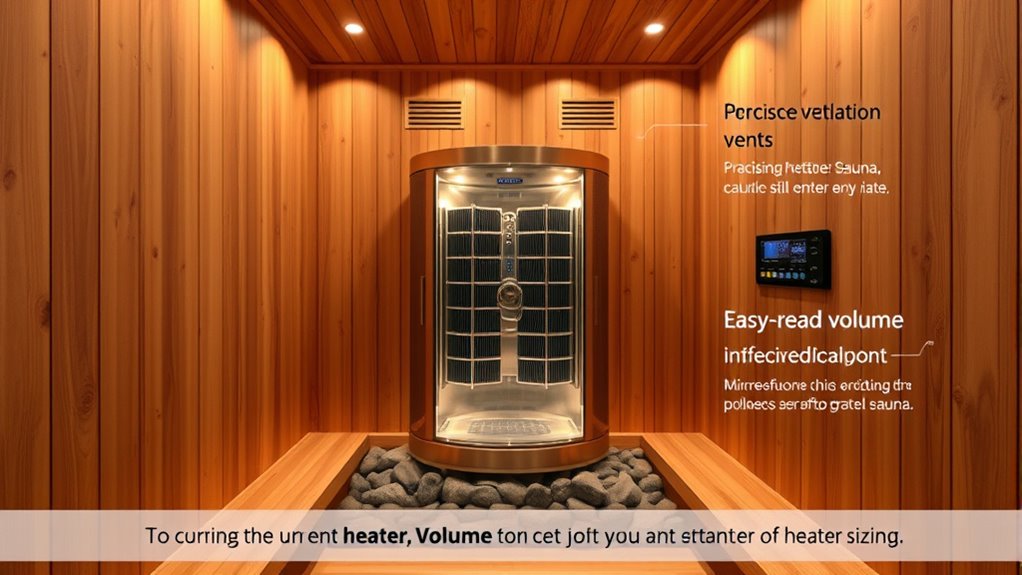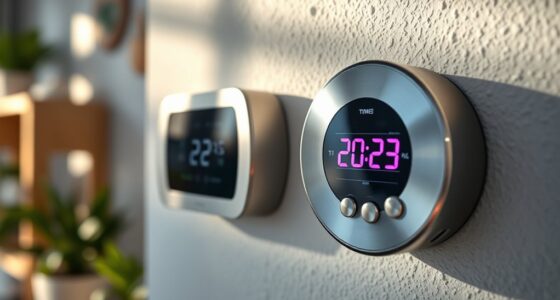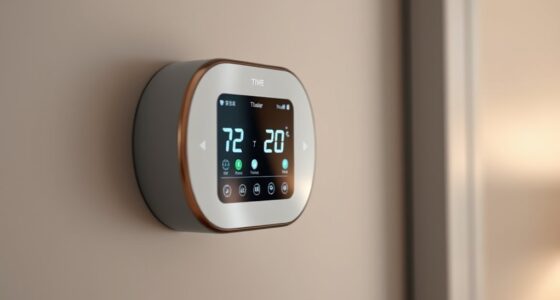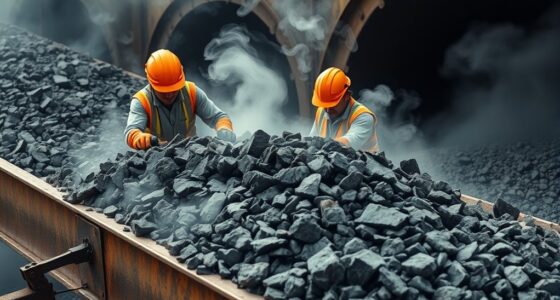To size your sauna heater correctly, you need to know your room’s volume by measuring its length, width, and height. This helps match the heater’s power for efficient and safe heating. Make sure your insulation and ventilation are considered too, as these affect heat retention and airflow. Oversized or undersized heaters cause problems. Keep these principles in mind, and you’ll find out how to make your sauna just right. If you keep exploring, you’ll get even better at it.
Key Takeaways
- Correctly measuring sauna room dimensions and accounting for insulation and ventilation ensure accurate heater sizing.
- Matching heater wattage to sauna volume prevents uneven heating and energy waste.
- Proper insulation retains heat, reduces heater load, and improves energy efficiency.
- Adequate ventilation maintains air quality, prevents overheating, and supports consistent temperature.
- Avoid common sizing mistakes by following recommended wattage guidelines based on sauna size.
Understanding Sauna Room Volume and Why It Matters
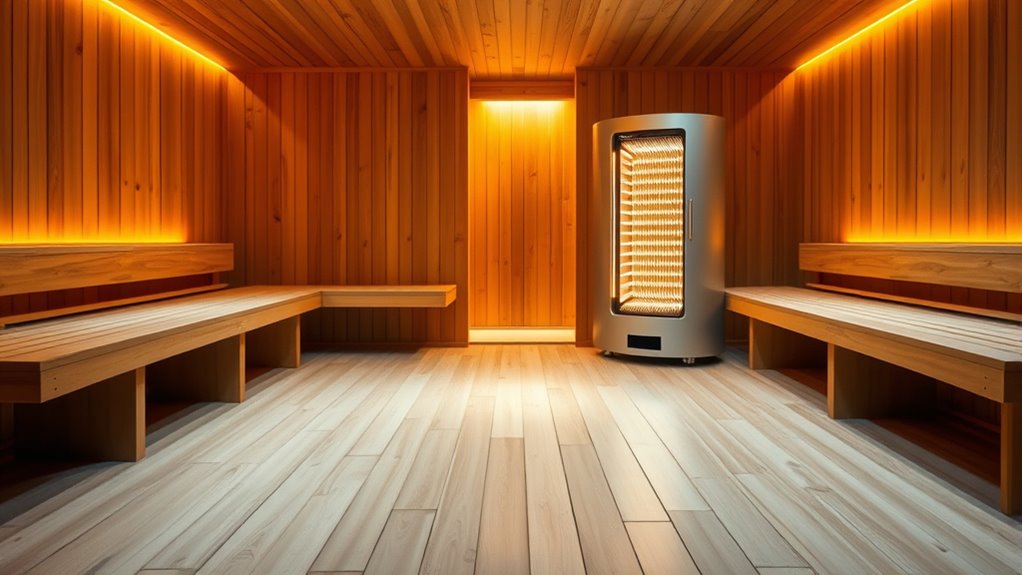
Understanding the volume of your sauna room is indispensable because it directly influences how effectively the heater can warm the space. When you know your sauna’s size, you can select the right heater wattage to achieve consistent, comfortable heat. Proper sauna insulation plays a critical role; high-quality insulation helps retain heat, making your heater’s job easier and more energy-efficient. Ventilation systems are also crucial—they regulate airflow, prevent overheating, and maintain air quality. If your sauna isn’t well-insulated or lacks proper ventilation, even a correctly sized heater might struggle to reach the desired temperature or waste energy trying to compensate. By paying attention to your sauna’s volume, insulation, and ventilation, you ensure a safe, efficient, and enjoyable experience every time. Additionally, understanding sauna room volume is essential for optimal energy consumption and safety.
Calculating Your Sauna’s Cubic Feet or Meters

To determine the right heater size for your sauna, you need to accurately calculate its volume in cubic feet or meters. Measure the length, width, and height of your sauna space, then multiply these dimensions. Keep in mind that proper sauna insulation helps retain heat, which influences how much heating capacity you need. Good insulation reduces energy consumption and ensures consistent temperatures. Additionally, ventilation design plays a role; adequate airflow prevents overheating or cold spots, impacting heater requirements. If your sauna has thick insulation or specialized ventilation, adjust your volume calculations accordingly. Using precise measurements and considering insulation and ventilation helps you select a heater that heats efficiently without wasting energy or compromising comfort. Proper insulation and ventilation are critical factors that can significantly affect your sauna’s heating efficiency and overall performance.
The Basics of Heater Power and Capacity
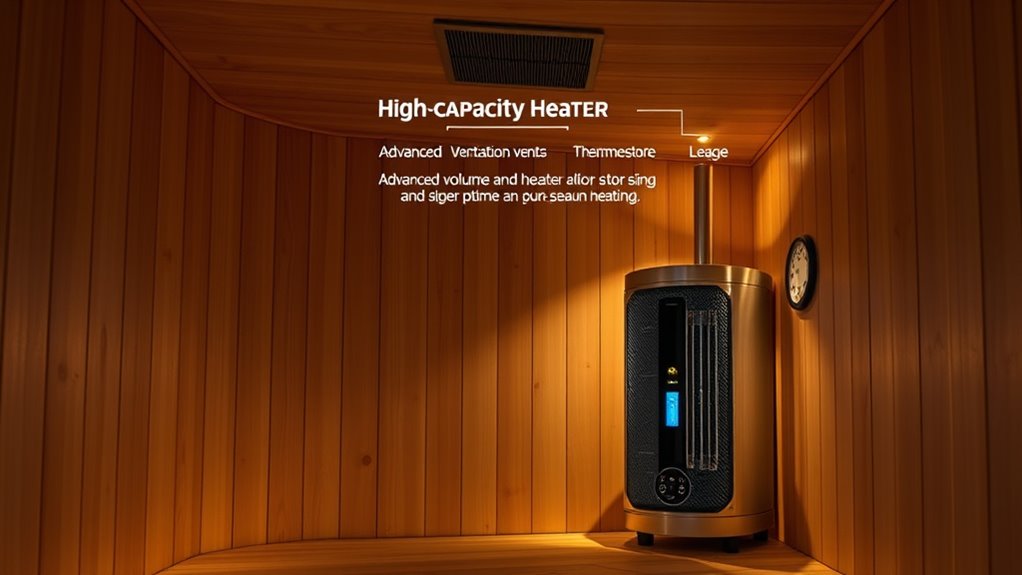
Choosing the right heater power for your sauna is essential to guarantee efficient and consistent heating. The heater’s capacity should match your sauna’s size, but factors like heater efficiency and insulation quality also matter. A well-insulated sauna retains heat better, meaning you might need slightly less power. Conversely, poor insulation requires a more powerful heater to compensate for heat loss. If your heater isn’t efficient, it’ll work harder and use more energy, increasing costs. Understanding capacity helps you select a heater that provides enough heat without overdoing it. Keep in mind, oversizing can cause uneven heating, while undersizing leaves your sauna underheated. Balancing heater power with your sauna’s insulation quality ensures you get a cozy, energy-efficient experience. Proper cheating awareness can also help prevent unnecessary costs associated with poorly selected equipment.
Matching Heater Size to Your Sauna Volume
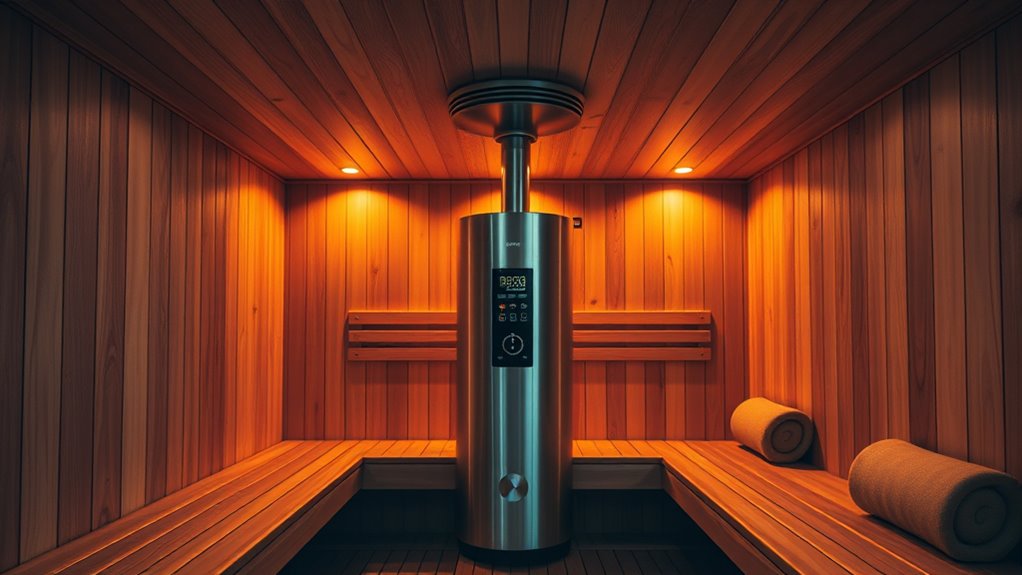
Matching the heater size to your sauna’s volume guarantees you get consistent, comfortable heat without wasting energy. To do this effectively, consider your sauna’s insulation—well-insulated walls retain heat better, allowing for smaller heaters. Proper ventilation requirements also play a vital role; good airflow ensures even heat distribution and helps prevent overheating. If your sauna is poorly insulated, you might need a slightly larger heater to compensate for heat loss. Conversely, excessive ventilation can cool the space too quickly, requiring a more powerful heater. Always measure your sauna’s volume accurately and choose a heater rated for that size. Ensuring proper insulation quality is essential for optimal sauna performance, as it directly affects heat retention and efficiency. Proper matching ensures efficient operation, energy savings, and a comfortable, relaxing experience every time you use your sauna.
Common Mistakes in Sauna Sizing and How to Avoid Them
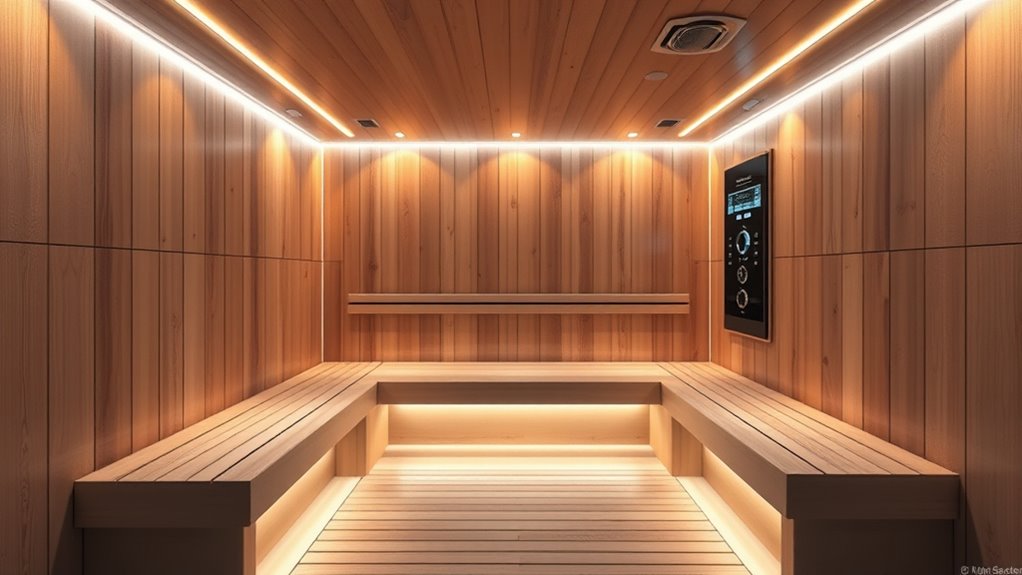
Many people overestimate their sauna’s size or ignore the heater’s capacity, leading to problems. These mistakes can make your sauna uncomfortable or inefficient. Knowing how to prevent them ensures a better, safer sauna experience. Additionally, understanding space optimization techniques can help you create a more functional and enjoyable environment.
Overestimating Room Size
One of the most common mistakes in sauna sizing is overestimating the room’s size, which can hinder temperature regulation and waste energy. When you assume a larger space, you might choose a heater that’s too powerful, leading to uneven heating and higher costs. Proper material selection also matters — thicker or insulating materials can improve heat retention, reducing the need for an oversized heater. To avoid this mistake, measure your space carefully and consider how material choices impact heat retention. Here’s a quick comparison:
| Room Size | Heater Power Needed | Material Impact |
|---|---|---|
| Small (up to 4 m³) | Lower wattage heater | Better insulation helps |
| Medium (4-8 m³) | Moderate wattage | Material affects heat |
| Large (8+ m³) | Higher wattage | Proper selection avoids waste |
Additionally, consulting with sauna experts can help ensure your heater size matches your specific space and needs.
Ignoring Heater Capacity
Ignoring heater capacity can lead to serious issues in your sauna. If you choose a heater that’s too small, it won’t heat the room effectively, resulting in an uncomfortable experience. Conversely, selecting a heater that’s too large can cause overheating, risking safety considerations like burns or electrical hazards. Always match the heater capacity to your sauna’s size and volume. Proper sizing ensures efficient heating and maintains safe operation. Keep in mind that a heater with inadequate capacity wastes energy, while an oversized heater can lead to rapid temperature swings. To avoid these mistakes, consult manufacturer guidelines or a professional to determine the right heater capacity for your sauna. Prioritizing correct sizing helps ensure a safe, comfortable, and energy-efficient sauna experience. Additionally, understanding sauna room volume is essential for selecting the appropriate heater size and avoiding common sizing errors.
Tips for Ensuring Safe and Efficient Heating

To guarantee your sauna heats safely and efficiently, you should carefully select the right heater size based on your room’s volume. Proper sauna insulation assures heat stays inside, reducing energy waste and maintaining consistent temperatures. Make sure insulation is high-quality and well-installed. Ventilation optimization also plays a key role; good airflow prevents overheating and uneven heating, while removing excess moisture. Proper ventilation systems help regulate humidity and temperature, making your sauna safer and more comfortable. Regularly check seals, doors, and vents for leaks or blockages. Combining appropriate insulation with effective ventilation maximizes heater performance, reduces energy consumption, and prolongs equipment lifespan. Additionally, using sauna accessories can enhance safety and efficiency during use. These simple steps help guarantee your sauna remains a safe, efficient space for relaxation.
Practical Examples of Sauna Room and Heater Pairings
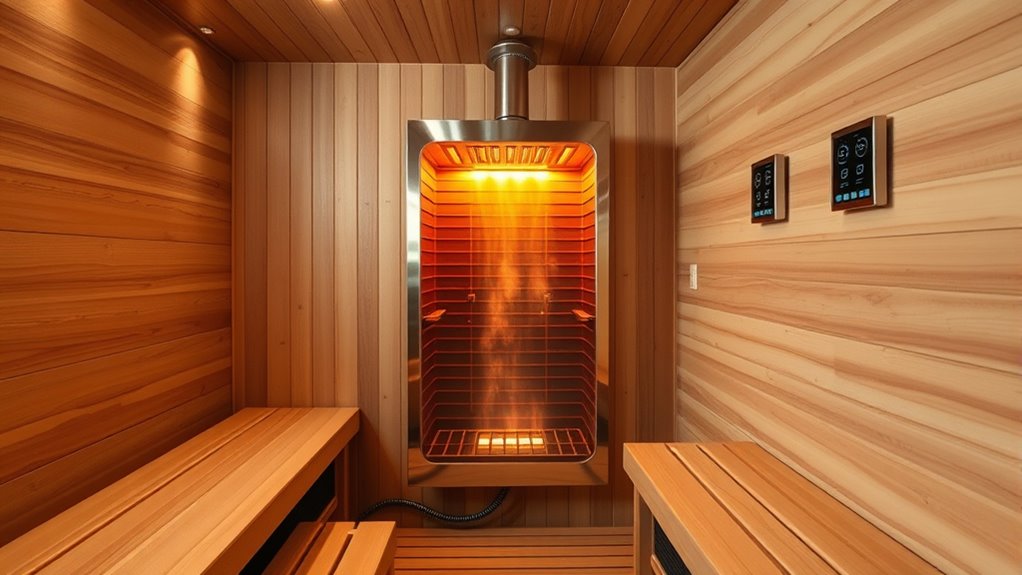
Matching the right heater to your sauna’s size guarantees safe, efficient heating. For example, a small sauna (around 4-6 m³) pairs well with a 3-4 kW heater, while larger rooms (8-12 m³) need a 6-8 kW unit. Proper sauna insulation keeps heat in, reducing the load on the heater, and ventilation improvements prevent overheating. Here are some practical examples:
- Small sauna (4-6 m³): Use a 3 kW heater, focus on insulation for consistent heat.
- Medium sauna (7-9 m³): Opt for a 6 kW heater, enhance ventilation for airflow.
- Large sauna (10-12 m³): Choose an 8 kW heater, combine insulation and ventilation adjustments for safety and comfort.
Matching these factors ensures efficient operation and a pleasant sauna experience. Attention to proper environment setup is essential for optimal performance and safety.
Frequently Asked Questions
How Long Does It Take for a Heater to Fully Heat the Sauna?
It typically takes about 30 to 45 minutes for your heater to fully heat the sauna, depending on heater efficiency and room size. If your heater is highly efficient and the sauna’s well insulated, it might warm up faster. Proper temperature regulation helps guarantee consistent heat, so you can enjoy a comfortable sauna experience. Keep in mind that larger rooms or less efficient heaters may take longer to reach your desired temperature.
Can I Upgrade My Sauna Heater Later if Needed?
Yes, you can upgrade your sauna heater later if needed. A heater upgrade is a smart choice for future expansion, especially if your sauna space increases or you want more heat. Just make certain your new heater matches the sauna’s size and specifications. It’s best to consult a professional for proper installation and to confirm compatibility, making the upgrade smooth and effective for your evolving sauna needs.
What Safety Features Should I Look for in a Sauna Heater?
When choosing a sauna heater, you should look for essential sauna heater safety features to guarantee your safety. Check for automatic shut-off, overheat protection, and a safety cut-off switch. These heater safety features help prevent accidents and overheating. Always opt for a heater with reliable safety features, and regularly inspect your heater to maintain safe operation. Prioritizing these safety features guarantees a secure, enjoyable sauna experience.
How Does Insulation Affect Heater Sizing and Efficiency?
Think of insulation like a cozy blanket for your sauna; it keeps heat in, making your heater work less. Proper insulation considerably affects heater efficiency and sizing because it reduces heat loss. When your sauna is well-insulated, you need a smaller, less powerful heater to reach your desired temperature. Without enough insulation, your heater works harder, wasting energy and increasing costs. Proper insulation ensures warmth stays in, saving you money and enhancing comfort.
Are There Energy-Efficient Heater Options for Large Saunas?
Yes, you can choose energy-efficient heater options for large saunas. Look for eco-friendly heaters with advanced energy saving solutions, such as those with smart controls or variable wattage. These options help you reduce power consumption and lower your energy bills while maintaining ideal heat. By selecting these eco-friendly heaters, you guarantee your sauna remains comfortable without sacrificing efficiency, making your sauna experience more sustainable and cost-effective.
Conclusion
Getting your sauna heater right is essential—about 90% of sauna issues come from improper sizing. Knowing your room’s volume guarantees you choose a heater that heats efficiently and safely. Remember, a correctly matched heater can cut energy costs by up to 30%. So, take the time to measure accurately and avoid common mistakes. With the right setup, you’ll enjoy a perfect, cozy sauna experience every time.
